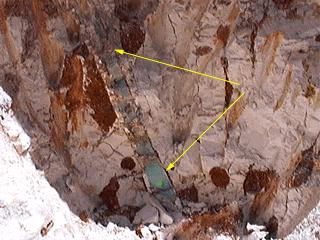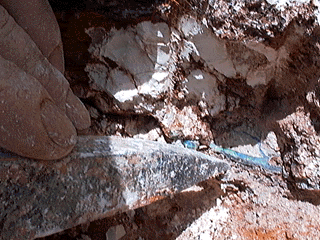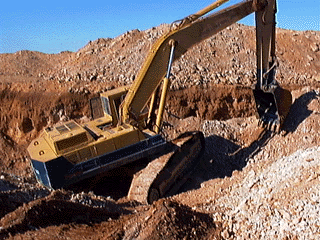
My job here was as a ‘checker’; one who examines the face that is exposed with each new bite of the bucket of the excavator. What is exposed, and what is pulled off the wall must be probed and brushed and spat upon in an attempt to locate the beginning of a new seam of opal, or the end of one that was pulled down by the last bite of the bucket.
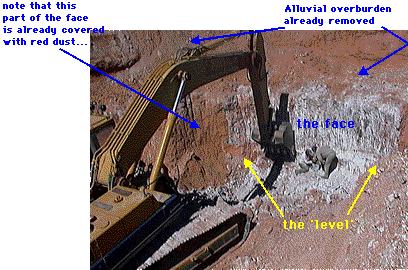
Opal frequently forms in the level, or just above this level, in fractures in the bulldog shale that are caused by shifting of the earth, as well as water and thermal ‘weathering’.
Next is a picture of an older mine which was nearby ours, and shows evidence of at least three different attempts to discover opal in the ‘levels’.
There must have been some initial probe into the area which indicated that there was a ‘level’ here, which showed some ‘trace’ of potch or ‘color’.
Perhaps a bulldozer came in and made a strafing run on the area, causing the widest ‘cut’ feature shown. It’s a toss-up as to whether someone with a pick dug into the wall at the right, or an excavator made the deeper cut beneath the cut of the bulldozer. Note that the vegetation at the ‘level’ is a good indicator of the timing and the extent of each of the attempts that are made by different ‘gangs’ of miners.
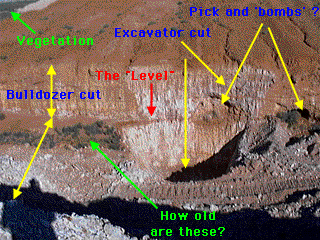
It might also be that a very old hand-dug mine (drive) on the right was exposed by the first bulldozer cut and note that it is also along the ‘level’.
This is just a small scale example of some of the opal fields where it is no longer possible to figure out the sequence of these cuts at all.
So there you are, in the hole, eating and inhaling flies and dust. There is no conversation, as the flies love your mouth even more. The only thoughts on your mind are the patterns of cracks and relative softness of the host rock.
There it is !
All of a sudden, there is a very thin line where what had been just red dust in a tiny crack, became ‘opal’. Sometimes this is nothing but ‘potch’, or opal without ‘fire’, but this can be an indication that more precious material might pop out with the next bite of the bucket.
Here is a ‘vertical’ that yielded some very beautiful blue-green crystal opal about as thick as your index finger, but only about 3 inches deep into the wall.

